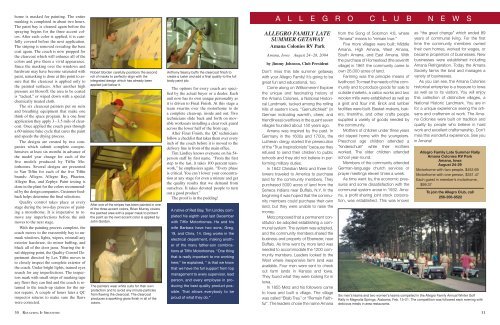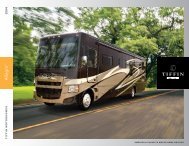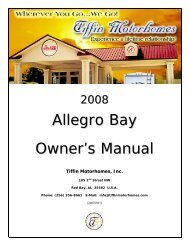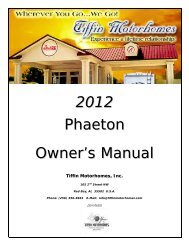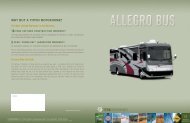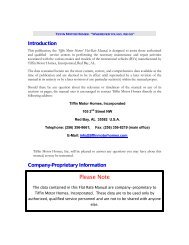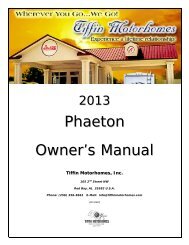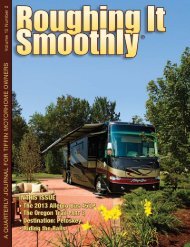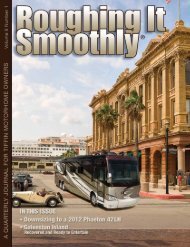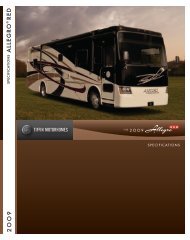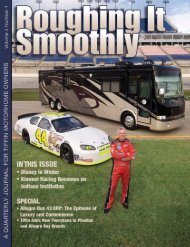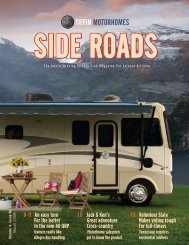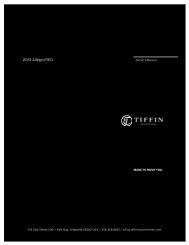Roughing It Smoothly - Tiffin Motorhomes
Roughing It Smoothly - Tiffin Motorhomes
Roughing It Smoothly - Tiffin Motorhomes
- No tags were found...
Create successful ePaper yourself
Turn your PDF publications into a flip-book with our unique Google optimized e-Paper software.
home is masked for painting. The entiremasking is completed in about two hours.The paint bay is cleaned again before thespraying begins for the three accent colors.After each color is applied, it is carefullycovered before the next application.The striping is removed revealing the basecoat again. The coach is now prepped forthe clearcoat which will enhance all of thecolors and give them a vivid appearance.Since the masking over the windows andhardware may have become saturated withpaint, remasking is done at this point to assurethat the clearcoat is applied only tothe painted surfaces. After another highpressure air blowoff, the area to be coatedis “tacked,” or wiped down with a specialchemically treated cloth.The six clearcoat painters put on suitsand breathing equipment that make onethink of the space program. In a one hourapplication they apply 3 – 3.5 mils of clearcoat.Once applied the coach goes througha 60-minute bake cycle that cures the paintand speeds the drying process.The designs are created by two companieswhich submit complete comprehensivesat least six months in advance ofthe model year change for each of thefive models produced by <strong>Tiffin</strong> <strong>Motorhomes</strong>.Several designs are presentedto Van <strong>Tiffin</strong> for each of the five <strong>Tiffin</strong>brands: Allegro, Allegro Bay, Phaeton,Allegro Bus, and Zephyr. Paint testing isdone in the plant for the colors recommendedby the design companies. Customer feedbackhelps determine the final selections.Quality control takes place at everystage during the two-day process of paintinga motorhome. <strong>It</strong> is imperative to removeany imperfections before the unitmoves to the next stage.With the painting process complete, thecoach moves to the reassembly bay to unmaskwindows, lights, wipers, reinstall anyexterior hardware, do minor buffing, andblack all of the door jams. Nearing the finalshipping point, the Quality Control Departmentdirected by Lex <strong>Tiffin</strong> moves into closely inspect the complete exterior ofthe coach. Under bright lights, trained eyessearch for any imperfections. The inspectorsmark with small strips of masking tapeany flaws they can find and the coach is returnedto the touch-up station for the minorrepairs. A couple of hours later a QCinspector returns to make sure the flawswere corrected.Robert Borden carefully positions the secondroll of masks to perfectly align with theintegrated design which has already beenapplied just below it.After one of the stripes has been painted in oneof the three accent colors, Brian Murray coversthe painted area with a paper mask to protectthe paint as the next accent color is applied byJohn Gordon.The painters wear white suits for their ownprotection and to avoid any minute particlesfrom flawing the clearcoat. The clearcoatproduces a sparkling gloss finish in all of thecolors.Anthony Searcy buffs the clearcoat finish tocreate a luster and add a final quality to the fullbody paint job.The options for every coach are specifiedby the actual buyer or a dealer. Eachunit now has its own unique personality asit is driven to Final Finish. At this stage ateam swarms over the motorhome to doa complete clean-up, inside and out. Twotechnicians slide back and forth on movableworkseats installing a clear rock guardacross the lower half of the front cap.After Final Finish, the QC techniciansfollow a checklist that takes them over everyinch of the coach before it is moved to thedelivery line in front of the main office.Tim Lindley knows everyone on his 54-person staff by first name. “From the firststep to the last, it takes 100 percent teamwork,”he emphasizes again. “Every phaseis critical. You can’t lower your concentrationat any stage for even a minute and getthe quality results that we demand fromourselves. <strong>It</strong> takes devoted people to turnout a good product.”The proof is in the pudding!A native of Red Bay, Tim Lindley completedhis eighth year last Decemberwith <strong>Tiffin</strong> <strong>Motorhomes</strong>. He and hiswife Barbara have two sons, Greg,19, and Chris, 14. Greg works in theelectrical department, making anotherof the many father-son combinationsat <strong>Tiffin</strong> <strong>Motorhomes</strong>. “One thingthat is really important to me workinghere,” he explained, “ is that we knowthat we have the full support from topmanagement to every supervisor, leadperson, and every employee in producingthe best quality product possible.That allows everybody to beproud of what they do.”A L L E G R O C L U B N E W SALLEGRO FAMILY LATESUMMER GETAWAYAmana Colonies RV ParkAmana, Iowa August 24–28, 2004by Jimmy Johnson, Club PresidentDon’t miss this late summer getawaywith your Allegro Family! <strong>It</strong>’s going to begreat fun and educational, too.Come along on Willkommen! Explorethe unique and fascinating history ofthe Amana Colonies, a National HistoricalLandmark, tucked among the rollinghills of eastern Iowa. “Gemutlichkeit” (inGerman indicating warmth, cheer, andfriendliness) overflows in the quaint sevenvillages founded about 150 years ago.Amana was inspired by the past. InGermany in the 1600s and 1700s, theLutheran clergy started the persecutionof the “True Inspirationists” because theyrefused to send their children to publicschools and they did not believe in performingmilitary duties.In 1842 Christian Metz and three followerstraveled to America to purchaseland for the community members. Theypurchased 5000 acres of land from theSeneca Indians near Buffalo, N.Y. In thebeginning it was hoped that the communitymembers could purchase their ownland, but they were unable to raise themoney.Metz proposed that a permanent constitutionbe adopted establishing a communalsystem. The system was adopted,and the community members shared thebusiness and property of Ebenezer, nearBuffalo. As time went by more land wasneeded to accommodate the 1200 communitymembers. Leaders looked to theWest where inexpensive farm land wasavailable. Four men were sent to checkout farm lands in Kansas and Iowa.They found what they were looking for inIowa.In 1855 Metz and his followers cameto Iowa and built a village. The villagewas called “Blaib Treu” or “Remain Faithful”.The leaders chose the name Amanafrom the Song of Solomon 4:8, where“Amana” means to “remain true.”Five more villages were built: MiddleAmana, High Amana, West Amana,South Amana, and East Amana. Withthe purchase of Homestead (the seventhvillage) in 1861 the community came toown 26,000 acres of land.Farming was the principle means oflivelihood. To meet the needs of the communityand to produce goods for sale tooutside markets, a calico works and twowoolen mills were established as well asa grist and flour mill. Brick and lumberfacilities were built. Basket-makers, bakers,tinsmiths, and other crafts peoplesupplied a variety of goods needed bythe community.Mothers of children under three yearsold stayed home with the youngsters.Preschool age children attended a“kinderschule” while their mothersworked. The older children attendedschool year-round.Members of the community attendedGerman-language church services orprayer meetings eleven times a week.As time went by, the economic pressuresand some dissatisfaction with thecommunal system arose in 1932. Amana,a profit sharing joint stock corporation,was established. This was knownas “the great change” which ended 89years of communal living. For the firsttime the community members ownedtheir own homes, worked for wages, orbecame proprietors of businesses. Newbusinesses were established includingAmana Refrigeration. Today the AmanaSociety farms the land and manages avariety of businesses.As you can see, the Amana Colonieshistorical enterprise is a treasure to Iowaas well as to its visitors. You will enjoythis collection of distinctive villages, aNational Historic Landmark. You are infor a unique experience seeing the artisansand craftsmen at work. The AmanaColonies were built on tradition andquality by people who believe in hardwork and excellent craftsmanship. Don’tmiss this wonderful experience. See youin Amana!Allegro Family Late Summer RallyAmana Colonies RV ParkAmana, IowaAugust 24-29Motorhome with two people, $452.69Motorhome with one person, $351.47Each guest in member’s motorhome,$99.37To join the Allegro Club, call256-356-8522Six men’s teams and two women’s teams competed in the Allegro Family Annual Winter GolfRally in Magnolia Springs, Alabama, Feb. 15–21. The competition was followed each evening withdelicious meals in area restaurants.30 ROUGHING IT SMOOTHLY31


